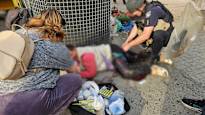KIEV Imagine that you are sitting on a bus on your way to the city. When it’s time to get off the bus, a grenade falls from the sky.
This is now the reality for civilians in the city of Kherson in southern Ukraine, where the Russians have started chasing people with remote-controlled drones.
– There are many cases, almost every day. In September alone, 2,700 grenades were dropped from Mavic drones, the city’s military spokesman said Alexander Tolokonnikov says to .
The Mavic is a drone that can carry a grenade or even a mine. Their use is common at the front.
Herson had already experienced hardships since the start of the Russian war of aggression. The city was tested by the Russian occupation, the flood caused by the explosion of the Kahovka dam, and constant artillery fire on the city. A week and a half ago, the Russians attacked the market in the center of the city with artillery. Six people died in the attack.
However, chasing people with drones is downright sick even by Russian standards. Six have been killed and 148 injured as a result of grenades dropped from the air in September alone, Tolokonnikov says.
The locals have started call the phenomenon for a “human safari”.
– They drop grenades at bus stops and on the roofs of buses. In addition, they drop mines that they try to disguise as unrecognizable, Tolokonnikov says.
The Russians have published aerial videos of Hersonis on social media. They show how drones drop grenades, for example, on the neck of a person stepping out of a civilian car.
The X-message service publication below contains video footage filmed by the Russians from their drones in Kherson. Video can shock.
– They don’t want to return empty-handed. When they can’t find the soldiers, they drop the explosives on the civilians. Then they get another grenade and come back hoping that a soldier will hit the spot, Tolokonnikov says.
Director of the drama theater located in the center of Kherson Oleksandr Knyga says Russians are downright paranoid.
– They write on their channels that they are terrorizing the civilian population until we reveal to them the positions of Ukrainian soldiers, Knyga says.
He tells a possible reason for the increased terror of the Russians: Russian soldiers have been replaced by young people who fly drones.
Knyga says that he heard from his acquaintances on the occupied opposite bank that the presence of Russians in the area has decreased. The soldiers have possibly been moved to the Kursk region, where Ukraine invaded two months ago.
met Knyga in Hersoniss in February. At that time, a grenade hit nearby:
Knyga tells about a case where a drone chased a goat walking in the yard of a house. When an elderly woman stepped out of her house to see why the goat was behaving restlessly, the drone dropped a grenade. The goat was torn to pieces, but the grandmother’s spirit survived.
– I can only imagine how these non-humans look at the monitor and laugh, Knyga says.
Drones are difficult to combat
The city of Kherson is separated from the occupied Kherson region by the wide Dnipro River.
Tolokonnikov says it is difficult for the Ukrainians to prevent drones carrying grenades from flying into the city.
– Electronic jamming does not work on Mavic drones. The Russians can’t stop our Mavics from flying to their stations either. For now, they can only be shot down with a shotgun, Tolokonnikov says.
Tolokonnikov told in Kherson last February that the Russian attacks on Kherson were simply revenge for Ukraine’s success in liberating the city.
He sees no military reason or sense for the actions of the Russians. If the Russians’ goal is to clear the city of civilians, it would also be easier for the Ukrainian army to take countermeasures.
– I see no other reason than bloodlust. Their goal is simply to kill as many Ukrainians as possible, Tolokonnikov says now.
Before the war, Kherson, known for its watermelons, had about 300,000 people, now only 64,000. Most of those who stayed in the city are elderly people who have nowhere else to go, Tolokonnikov says.
– Nervousness in the city has increased. People look up to the sky all the time and try to spot a drone, says Tolokonnikov.
According to Tolokonnikov, living under constant threat changes people, and the reality of the townspeople has changed. According to him, it can be difficult for Europeans to understand.
